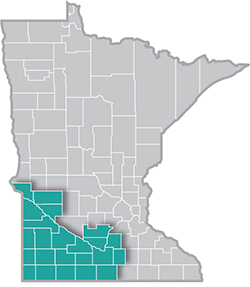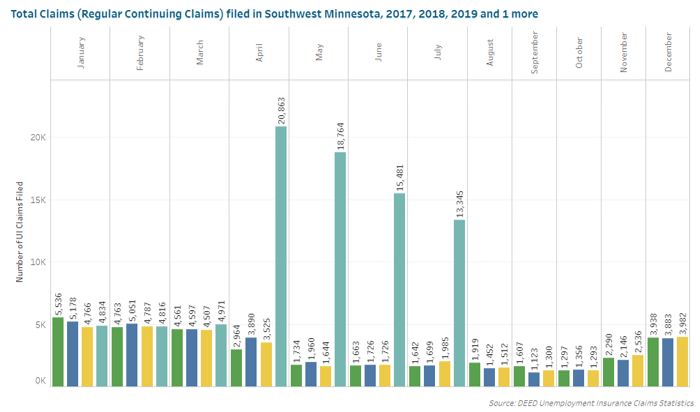 Southwest Minnesota is a national leader in agricultural production, and renewable energy.
Southwest Minnesota is a national leader in agricultural production, and renewable energy.
The region's thriving manufacturing sector includes food processing, machinery, printing, metal products, and computers and electronic products.
Want the freshest data delivered by email? Subscribe to our regional newsletters.
9/9/2020 9:00:00 AM
Luke Greiner
After seeing a spike of Unemployment Insurance (UI) claims in April and May, data from DEED's UI claims statistics program shows that people who lost work in Southwest Minnesota are returning to work. After reaching a peak of 20,863 continuing claims for UI benefits in April, the number of continuing claims dropped to 13,345 in July, meaning about 7,500 have likely returned to their jobs (see Figure 1).

The data clearly show that the economic recovery is underway in the region, but demographic details included in the UI claims statistics show that it has been uneven. This is most notable among Black, Indigenous and People of Color (BIPOC) workers, who were more likely to have been laid off at the outset of the coronavirus pandemic, and remain more likely to be filing continuing claims.
The largest number of continuing claims (weekly requests from people still receiving UI benefits) has been filed by white workers, though they also make up more than 93% of the region's labor force. In July, over 11,000 of the 13,344 continuing claims were filed by workers who identify as white, accounting for 82.5% of total claims activity. In contrast, about 6.5% of continuing claims were filed by Black or African American workers, despite that racial group making up just 1.7% of the total labor force in the region. Likewise, American Indians accounted for 1.2% of claims but just 0.5% of the labor force, and Asian or Other Pacific Islanders made up 1.7% of workers but 2.3% of claims in July.
While the number of continuing claims dropped about 14% from June to July, it fell 15% for white workers, compared to just a 2% decline for Black or African American workers. While BIPOC workers make up a small portion of the region's labor force, they have experienced a disproportionate employment impact during the pandemic (see Table 1).
| Table 1. Continuing Claims in Southwest Minnesota,
July 2020 |
Number of Continuing Claims,
|
Percent of Continuing Claims,
|
Change from June-July |
|---|---|---|---|
| White | 11,011 | 82.5% | -14.8% |
| Black or African American | 870 | 6.5% | -1.8% |
| American Indian/Alaska Native | 159 | 1.2% | -14.1% |
| Asian or Other Pacific Islander | 304 | 2.3% | -14.1% |
| Race Unknown | 1,000 | 7.5% | -11.9% |
| Total | 13,344 | 100.0% | -13.8% |
| Source: DEED Unemployment Insurance Claims Statistics | |||
Much of this disparate impact is due to the industries that workers of color are employed in – including Manufacturing, Health Care and Social Assistance, Accommodation and Food Services, and Retail Trade; all of which have suffered larger numbers of layoffs in the region. In fact, nearly 20% of continuing claims in July in the Southwest region were in the Manufacturing industry, which is by far the highest concentration of any region in the state. In addition, the other three industries listed above accounted for another 42% of continuing claims in July – meaning 60% of the layoff activity in the region is lingering in the four industries that have the largest number of BIPOC workers.
As the recovery continues and workers get back to work, it will be important for employers and CareerForce workforce development partners in the region – like the Southwest Minnesota Private Industry Council and the South Central Workforce Council – to understand the dynamics and the demographics of the workforce members that were most greatly impacted. Jobseekers can contact their local CareerForce location or visit the CareerForceMN.com website to get help in their job search and with finding new jobs in demand during COVID-19.
Contact Labor Market Analysts Luke Greiner at 320-308-5378 or Mark Schultz.